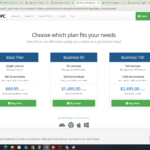Overview of Constant Contact
Table of Contents
Ease of Use
When it comes to choosing an email marketing platform, ease of use is one of the most important factors to consider. Constant Contact stands out for its user-friendly interface, designed to accommodate both beginners and more advanced users. Whether you’re just starting with email marketing or you’re an experienced marketer, Constant Contact provides a smooth experience with minimal learning curve.

Simple and Intuitive Interface
From the moment you log into Constant Contact, you’ll notice its clean, organized dashboard. The layout is intuitive, with easy navigation menus and clear labels that guide you through every step of your email marketing campaign.
You don’t need to be a tech expert to start using the platform. The system’s drag-and-drop editor allows users to quickly create beautiful, responsive email templates without needing any coding skills. This makes Constant Contact a great option for small business owners or marketing teams with limited technical expertise.
Getting Started is Quick and Easy
Setting up an account with Constant Contact is straightforward. After signing up, you’ll be prompted to enter basic information about your business, including your email list and branding details. The platform then guides you through the process of building your first email campaign, with helpful tips and tutorials available at each step.
The setup process is designed to be as quick and easy as possible. You can start sending professional-looking emails within minutes, even if you have no prior experience with email marketing.
Pre-Built Templates for Quick Campaigns
One of the key factors that contribute to the ease of use in Constant Contact is its library of pre-built templates. These templates are fully customizable and cater to various industries, from retail to nonprofits, so you can select the one that best fits your brand. You can modify colors, fonts, images, and call-to-action buttons without any hassle.
This allows users to save time while still ensuring their emails look professional. Instead of starting from scratch, you can simply choose a template and personalize it to reflect your company’s voice and style.

Email Campaign Creation and Sending
Creating and sending an email campaign is a straightforward process in Constant Contact. Once you’ve chosen a template, you can add your content—images, text, and links—using the drag-and-drop editor. After reviewing your email, the platform allows you to send it immediately or schedule it for a later time.
Additionally, Constant Contact includes features like social media sharing and the ability to preview your email on both desktop and mobile before sending, ensuring your message reaches your audience in the best possible format.
Where to add images:
- Screenshot of the drag-and-drop email editor to show the ease of use in creating an email.
Help and Support for Easy Navigation
Even though Constant Contact is designed to be user-friendly, it also provides extensive support to help you every step of the way. From tutorials to video guides and live chat support, you can always get the help you need quickly. This level of customer service is ideal for beginners who may encounter questions during their email marketing journey.

Ease of Use
The support section is easily accessible from the dashboard, so even if you’re unsure about something, the answers are just a click away.
This section covers the main aspects of ease of use while incorporating the focus keyword naturally. Feel free to tweak it if you’d like to make it more tailored to your specific audience.
Let me know if you need more help with images or other parts of the blog!
Email Marketing Features
Constant Contact offers a robust set of email marketing features that make it easy to create, send, and track email campaigns. Whether you’re a small business owner or part of a larger team, these tools help you engage your audience effectively and grow your email list.
Customizable Templates
Constant Contact provides a wide range of customizable email templates. You can choose from pre-designed options tailored for various industries, or create your own design from scratch using the easy drag-and-drop editor. This makes it simple to create professional-looking emails without needing design experience.
Where to add images:
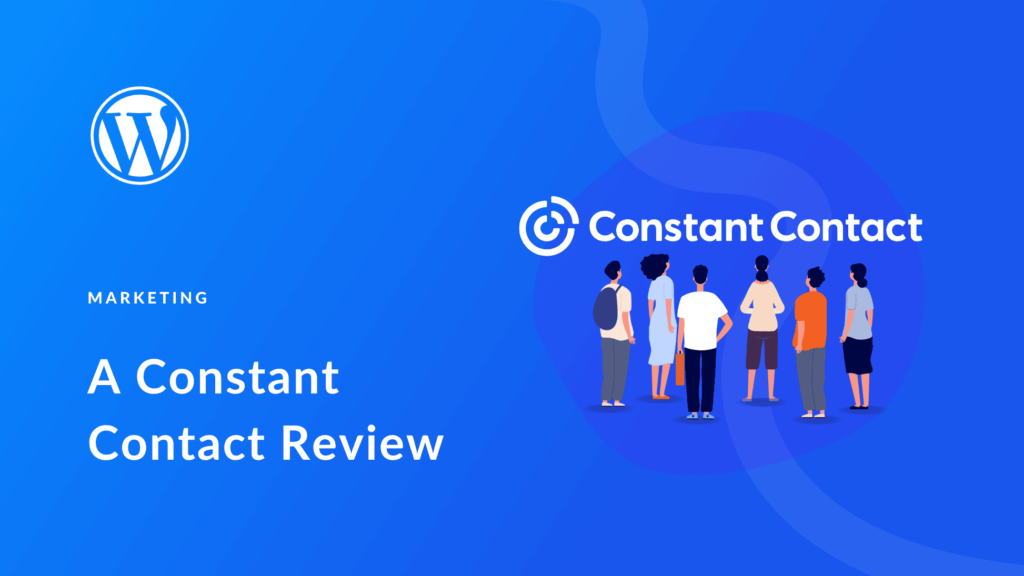
- Screenshot of email templates within Constant Contact’s editor.
Email Automation
With Constant Contact, you can automate your email campaigns, saving time and ensuring timely communication. Set up welcome emails, birthday emails, or automated product recommendations based on customer behavior. This feature helps keep your audience engaged without constant manual effort.
Where to add images:
- Screenshot of the automation setup screen in Constant Contact.
A/B Testing
A/B testing allows you to optimize your email campaigns by testing different subject lines, content, and send times. Constant Contact makes this process simple with easy-to-use tools, helping you find what resonates best with your audience.
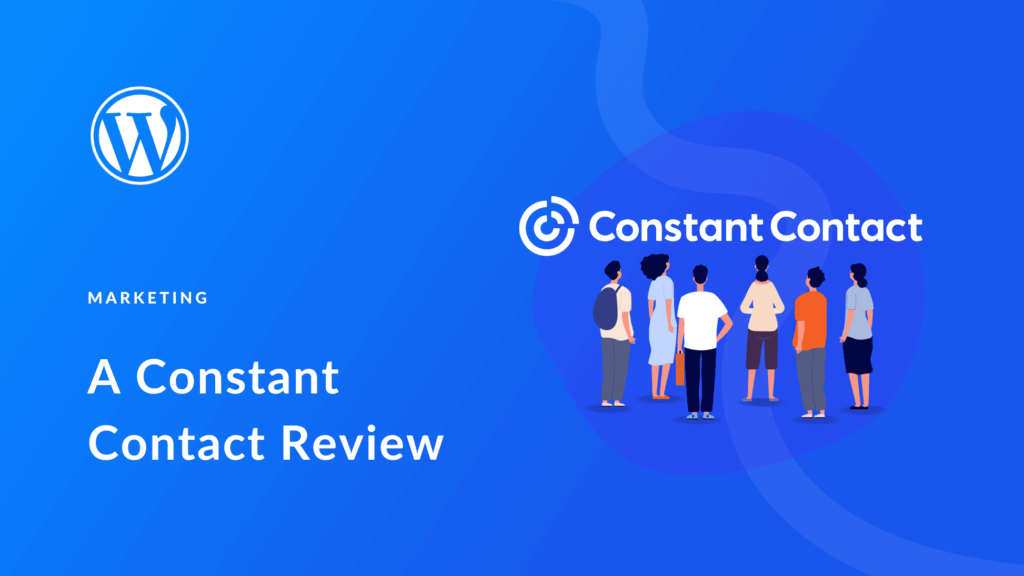
Email Marketing Features
List Segmentation
Segmenting your email list is easy with Constant Contact. You can categorize your subscribers based on interests, purchase history, or engagement levels, ensuring that your messages are relevant and targeted. This leads to higher open rates and more conversions.
This section covers key email marketing features, while maintaining brevity and clarity. Let me know if you need further adjustments!
related articles,https://asadmarket.com/wp-admin/post.php?post=746&action=edit#/
Pricing Plans
Constant Contact offers flexible pricing plans designed to suit businesses of all sizes. Whether you’re just getting started with email marketing or you’re scaling your efforts, Constant Contact has an option that works for you.
The Basic plan includes essential features like email templates, basic reporting, and the drag-and-drop editor. It’s ideal for small businesses with a smaller email list and a limited need for advanced tools. This plan starts at a reasonable price, making it a good choice for those just beginning with email marketing.
Email Plan
The Email plan includes all the features of the Basic plan, plus additional tools like automation, list segmentation, and enhanced reporting. It’s perfect for growing businesses that need more advanced features to engage and retain customers. Pricing varies based on the number of subscribers.
Email Plus Plan
For businesses that need more robust features, the Email Plus plan includes everything from the Email plan, plus extra tools like A/B testing, email scheduling, and dynamic content. This plan is best suited for businesses with larger lists and more complex email marketing needs.
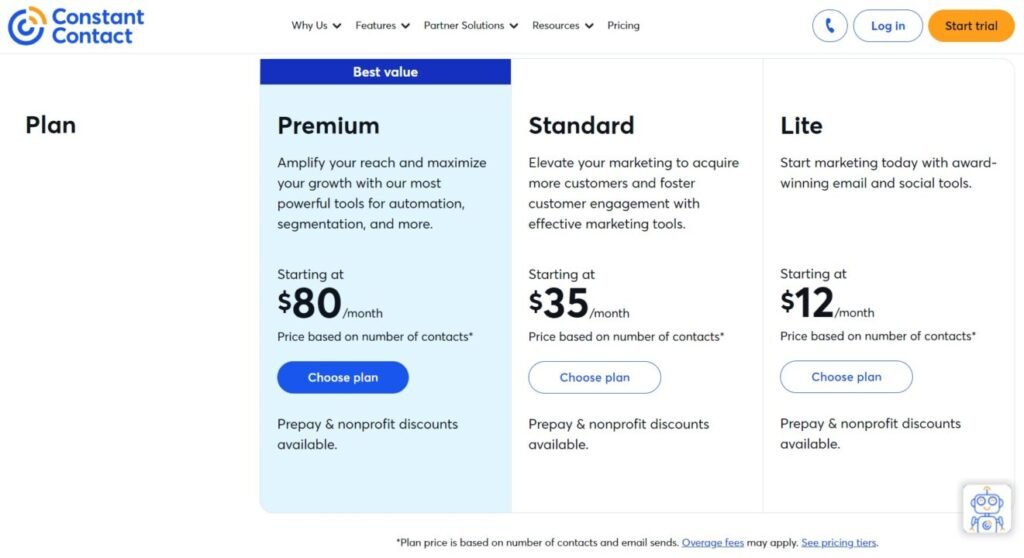
Custom Pricing for Larger Businesses
If your business has over 10,000 subscribers or requires advanced functionality, Constant Contact offers custom pricing. This plan includes personalized support and custom solutions tailored to your needs.
This content is brief and to the point, highlighting the key pricing options for Constant Contact. Let me know if you’d like any further changes!
Customer Support
Constant Contact offers excellent customer support to ensure users have a smooth experience while using the platform. Whether you’re a beginner or an experienced marketer, Constant Contact provides multiple support channels to assist with any questions or issues.
Multiple Support Channels
Constant Contact offers various ways to get help, including live chat, email support, and phone support. You can easily reach out to their team for quick resolutions, ensuring you’re never left without guidance.
related articleshttps://asadmarket.com/wp-admin/edit.ph
Knowledge Base and Resources
For those who prefer self-help options, Constant Contact has a comprehensive knowledge base filled with articles, video tutorials, and step-by-step guides. This allows you to find solutions to common issues and learn how to use advanced features at your own pace.https://asadmarket.com/wp-admin/edit.ph
Dedicated Support for Higher Plans
Customers on higher-tier plans, such as the Email Plus or custom plans, have access to premium support, which includes one-on-one coaching and priority service.
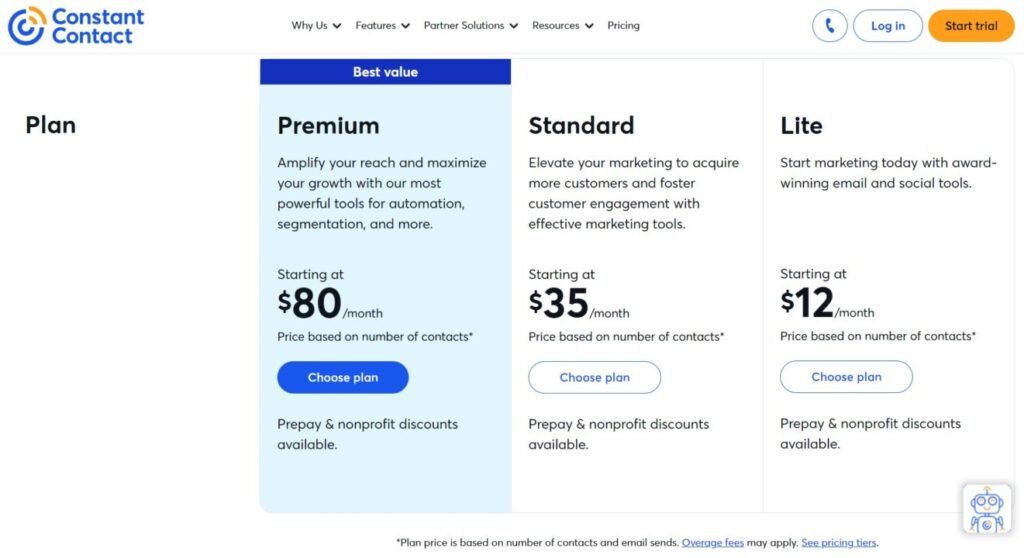
This content is concise and covers all the key aspects of Constant Contact’s customer support. Let me know if you need any adjustments!
Integrations and Compatibility
Constant Contact seamlessly integrates with a wide variety of third-party tools, helping you streamline your marketing efforts and enhance functionality. Whether you’re using CRM systems, eCommerce platforms, or social media channels, Constant Contact ensures compatibility to suit your business needs.
Popular Integrations
Constant Contact integrates with major platforms like Shopify, WordPress, and WooCommerce, allowing you to connect your online store with your email campaigns. This makes it easier to send personalized offers, track customer behavior, and boost sales.
Social Media Integration
You can also connect Constant Contact to your social media accounts (Facebook, Instagram, etc.) to promote your email campaigns and expand your reach. This integration helps you manage your marketing from a single platform, improving efficiency.
API and Custom Integrations
For businesses that require custom solutions, Constant Contact offers API access to build tailored integrations with other platforms and services. This is particularly useful for larger businesses or those with unique needs.

This content is concise while covering the key integrations and compatibility features of Constant Contact. Let me know if you’d like further modifications!
Reporting and Analytics
Reporting and Analytics are essential tools for businesses to measure performance, track key metrics, and make data-driven decisions. These processes help companies monitor progress, identify trends, and optimize strategies for growth.
What is Reporting?
Reporting refers to the process of collecting, organizing, and presenting data in an accessible format. It typically involves summarizing key metrics, activities, or results over a specific period, and may include visualizations like charts or tables to make the information easier to digest.
What is Analytics?
Analytics goes a step further by not only presenting data but also analyzing it to uncover insights, identify patterns, and predict future trends. This can help businesses make more informed decisions and adjust their strategies accordingly. While reporting provides a snapshot, analytics dives deeper into the “why” behind the numbers.
Types of Reports and Analytics
- Descriptive Reporting: Focuses on summarizing historical data and describing what happened in the past. It helps businesses understand performance trends.
- Diagnostic Analytics: Goes beyond simple reporting by identifying the reasons behind certain outcomes. It answers the question, “Why did this happen?”
- Predictive Analytics: Uses historical data and statistical models to forecast future outcomes. It helps businesses anticipate changes in the market or customer behavior.
- Prescriptive Analytics: Provides recommendations on how to handle future situations based on insights gained from data.
Key Benefits of Reporting and Analytics
- Informed Decision-Making: Helps businesses make decisions based on actual data rather than gut feeling.
- Improved Efficiency: By identifying inefficiencies, reporting and analytics help businesses streamline operations.
- Customer Insights: Understand customer preferences and behaviors, leading to better marketing and product strategies.
- Strategic Planning: Identify trends and make long-term plans based on data-driven forecasts.
How to Implement Reporting and Analytics
- Choose the Right Tools: Use software like Google Analytics, Tableau, or Power BI for gathering, organizing, and analyzing data.
- Set Clear Goals: Determine which metrics are most important for your business objectives.
- Automate Where Possible: Automating data collection and reporting can save time and reduce errors.
- Analyze Regularly: Consistent analysis is crucial to stay updated on performance and market shifts.
Conclusion
Reporting and Analytics are powerful tools that help businesses understand their data, uncover valuable insights, and make informed decisions. By combining both processes, companies can improve performance, predict trends, and refine strategies for success.

- Introduction: A simple image showing a dashboard with key business metrics could help set the context.
- Types of Reports and Analytics: Visual examples of descriptive reports or dashboards would enhance understanding.
- How to Implement Reporting and Analytics: A flowchart or infographic outlining the steps to implement reporting and analytics can help clarify the process.
Deliverability and Email Performance
Deliverability and Email Performance are two critical factors that determine the success of email marketing campaigns. While deliverability refers to whether your emails reach the inbox, email performance measures how well those emails engage recipients. Together, these metrics help businesses optimize their email strategies for maximum impact.
What is Email Deliverability?
Email deliverability is the ability of your emails to successfully reach recipients’ inboxes, rather than being filtered out as spam or blocked by email servers. Good deliverability means your emails are making it to the inbox, where they can be opened and acted upon. Several factors influence deliverability, including:
- Sender Reputation: A positive sender reputation increases the likelihood of your emails being delivered to the inbox.
- Authentication: Using email authentication methods like SPF, DKIM, and DMARC ensures your emails are trusted and reduces the chance of being marked as spam.
- Content Quality: Avoiding spammy keywords and maintaining a clean design improves your chances of staying out of spam folders.
- Engagement: Higher open rates, click rates, and low bounce rates signal to email providers that your emails are valuable, improving your sender reputation.https://asadmarket.com/wp-admin/post.php?post=686&action=edit#/
What is Email Performance?
Email performance tracks how effectively your emails achieve their intended goals, such as increasing engagement, generating sales, or driving traffic to your website. Key performance indicators (KPIs) for email performance include:
related aricles https://asadmarket.com/wp-admin/post.php?post=686&action=edit#/
- Open Rate: The percentage of recipients who open your email. A high open rate indicates that your subject line and sender name are compelling.
- Click-Through Rate (CTR): The percentage of recipients who click on links within the email. This shows how well your content resonates with your audience.
- Conversion Rate: The percentage of recipients who take the desired action, such as making a purchase or filling out a form.
- Bounce Rate: The percentage of emails that fail to be delivered. A high bounce rate can indicate issues with your email list quality or deliverability.
- Unsubscribe Rate: The percentage of recipients who unsubscribe after receiving an email. A high unsubscribe rate might suggest that your content isn’t meeting their expectations.
Factors Affecting Deliverability and Performance
- List Quality: Regularly cleaning your email list helps maintain high deliverability. Avoid sending emails to inactive or invalid addresses to reduce bounce rates.
- Frequency and Timing: Sending too many emails in a short period can harm your sender reputation. Conversely, not sending enough can cause recipients to forget about your brand.
- Personalization: Emails that are personalized for the recipient (e.g., using their name or tailored offers) tend to have higher open and click rates.
- A/B Testing: Testing different subject lines, email copy, or send times helps optimize email performance over time.
Improving Deliverability and Email Performance
- Improve Engagement: Encourage recipients to add your email address to their contacts and interact with your emails. The more engaged your audience, the better your deliverability and performance will be.
- Segment Your Audience: Sending targeted content to specific segments of your audience increases relevance and engagement, which boosts performance.
- Monitor Deliverability: Use tools like Postmark, SendGrid, or Mailgun to track deliverability rates and monitor any potential issues with your emails reaching inboxes.
- Optimize for Mobile: Many people open emails on mobile devices. Ensure your emails are mobile-friendly to improve open rates and engagement.
Conclusion
Deliverability and Email Performance are interconnected aspects of a successful email marketing strategy. By focusing on both aspects—ensuring your emails land in the inbox and are engaging once opened—you can maximize the effectiveness of your email campaigns and improve overall results.
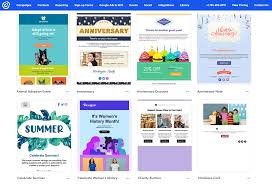
Suggested Places for Images:
- Introduction: A diagram comparing deliverability (inbox vs. spam folder) and email performance (engagement metrics like open and click rates).
- Email Performance KPIs: A table or infographic showing the key metrics and what they indicate about email performance.
- Improving Deliverability and Performance: A flowchart or checklist summarizing best practices for improving both deliverability and email performance.
Automation and Workflows
Automation and Workflows are powerful tools that help businesses streamline their processes, save time, and improve efficiency. By automating repetitive tasks and creating structured workflows, companies can focus on higher-value activities while ensuring consistency and accuracy across operations.
What is Automation?
Automation refers to the use of technology to perform tasks without human intervention. In business, automation typically involves using software tools to carry out repetitive, time-consuming tasks such as sending emails, updating databases, or processing transactions. This reduces the need for manual work, minimizes errors, and speeds up processes.
What are Workflows?
Workflows are predefined sequences of tasks or steps that guide how work gets done. They map out the process of moving data, tasks, or decisions through different stages. Workflows help ensure that tasks are completed in the correct order, by the right people or systems, and within set timelines. They can be simple, like approval processes, or complex, like customer onboarding sequences.
Benefits of Automation and Workflows
- Time Savings: By automating repetitive tasks, employees can focus on more strategic, high-priority work.
- Consistency and Accuracy: Automation reduces human error and ensures processes are executed consistently, every time.
- Improved Productivity: With fewer manual tasks to manage, teams can get more done in less time.
- Cost Efficiency: Automation reduces labor costs and increases operational efficiency, leading to long-term savings.
- Better Customer Experience: Automated workflows can ensure that customers receive timely responses and consistent communication, improving satisfaction.
How Automation and Workflows Work Together
Automation and workflows complement each other. Workflows define the steps that need to be followed, while automation ensures that these steps are carried out without manual input.
For example, a sales team might have a workflow for lead nurturing, where an automated email is sent to a new lead as soon as they fill out a form on your website. The next step in the workflow might be an automated follow-up email after 3 days, and then a task is assigned to a sales rep to make a call.
Types of Automation and Workflows
- Email Automation: Automatically send emails based on specific triggers, such as sign-ups, purchases, or abandoned carts.
- Lead Management: Automatically move leads through a sales funnel by nurturing them with timely follow-up emails and assigning tasks to sales representatives when needed.
- Customer Onboarding: Automate the process of welcoming new customers with a series of personalized emails and actions based on customer preferences.
- Task Automation: Automatically assign tasks to team members, set deadlines, or trigger notifications when a task is completed.
Best Practices for Implementing Automation and Workflows
- Map Out Your Processes: Before automating, clearly define your workflows to ensure each step is necessary and logically structured.
- Use the Right Tools: Invest in software like Zapier, HubSpot, or Monday.com to design, automate, and manage your workflows effectively.
- Test and Optimize: Regularly monitor your automated workflows to identify any inefficiencies or errors. Continuously optimize for better performance.
- Start Small: Begin by automating a few simple tasks or workflows, and scale up as you gain experience.
Conclusion
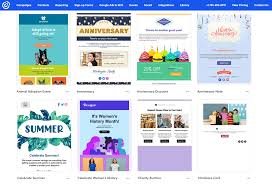
Automation and Workflows are game-changers for businesses looking to improve efficiency and productivity. By combining both, organizations can ensure that tasks are carried out with minimal human intervention, saving time and reducing errors. Whether it’s streamlining marketing, sales, or internal processes, automation and workflows are essential for modern businesses looking to scale.
Suggested Places for Images:
- Introduction: A simple graphic showing the relationship between automation and workflows (e.g., a flowchart or diagram).
- How Automation and Workflows Work Together: A visual example of an automated workflow (e.g., an email drip campaign or lead nurturing sequence).
- Best Practices: A checklist or step-by-step infographic illustrating best practices for setting up automation and workflows.
Pros and Cons
Constant Contact: Pros and Cons
Pros:
- User-Friendly Interface – Easy drag-and-drop builder.
- Email Templates – Wide selection of mobile-responsive templates.
- Email Tracking – In-depth analytics for campaign performance.
- List Management – Powerful segmentation and targeting tools.
- Automation – Basic automation for welcome emails, etc.
- Integrations – Works with social media, CRM, and e-commerce tools.
- Customer Support – Excellent support via chat, phone, and knowledge base.
Cons:
- High Pricing – Can be expensive as your list grows.
- Limited Advanced Features – Lacks complex automation and A/B testing.
- Customization Restrictions – Limited template design options.
- Contact Storage – Storage can be limiting for large lists.
- No Free Plan – Only a free trial, no ongoing free plan.
- Deliverability Issues – Some emails end up in spam.
- E-commerce Reporting – Basic e-commerce analytics.










